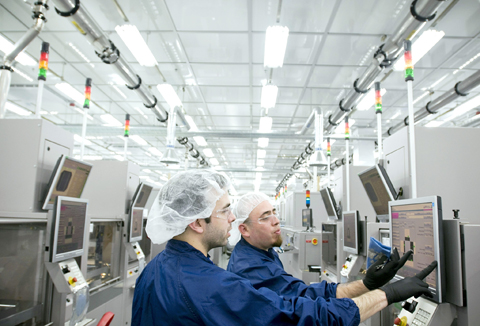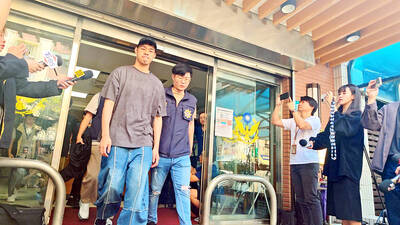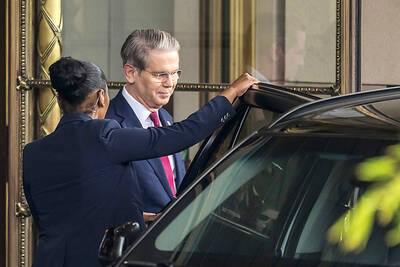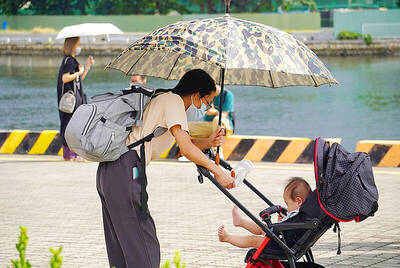Behind a giant solar factory, backhoes are digging away, preparing for a new wing that will quintuple production. Inside, an outspoken German executive named Boris Klebensberger is fretting about the color of the new carpet. Samples are perched on his window sill alongside floor plans.
Expanding a factory? Picking out carpeting?
Did anyone tell him there’s a recession?

PHOTO: NY TIMES NEWS SERVICE
Buoyed by the potential promise of a green economy, Klebensberger, who heads the US branch of SolarWorld AG, a company based in Bonn, Germany, is ramping up production of solar cells in a retrofitted factory that had its grand opening last October — in the teeth of the financial crisis.
“Was I worried about our position? No!” says Klebensberger, dismissing any hint that he was nervous at the opening.
And he remains just as bullish today. SolarWorld’s plant in Hillsboro, Oregon, which makes enough cells to fit 1,700 solar panels a day, is the biggest of its kind in the US.
For the residents of Hillsboro, and for the Oregon economy, SolarWorld’s presence is a welcome boon. Its employees enjoy being in start-up mode, while others like the cachet of working for a renewable-energy company.
“Green is the way to go,” says Michelle Zillig, who worked at Intel for 18 years before joining SolarWorld as a technician. “People can only have so many computers.”
At first glance, the timing of SolarWorld’s decision to invest US$500 million in the new site during a recession, in a state with an unemployment rate second only to Michigan’s, couldn’t have been worse. Prices for the company’s solar panels have slid about 15 percent since the factory opened, a result of growing competition and slowing demand, especially in Europe. Two manufacturers, GE Energy’s solar branch and BP Solar, have cut production in East Coast plants.
INCENTIVES
But new federal incentives to encourage renewable energy in the US will give the industry a boost, analysts say.
The recent stimulus package included grants for businesses and utilities that install solar energy systems, and the bank bailout package last year removed the dollar cap on a 30 percent tax credit for home installations. Makers of renewable energy equipment also received help in the stimulus package.
“I think the writing on the wall is the US is going to be the big market,” says Jesse Pichel, a solar analyst at Piper Jaffray.
The message for solar companies, Pichel says, is: “Get your butt over to the US if you want to participate and get some of that stimulus package money.”
The US lost its status as the world’s leading solar manufacturer in the 1990s as interest surged elsewhere. Now it makes little more than 5 percent of solar panels worldwide.
ROOM TO GROW
Even with federal support and positive buzz, only a fraction of 1 percent of the electricity in the US comes from solar panels, leaving ample room for the market to grow.
Germany, SolarWorld’s home, is at the same latitude as southern Alaska, often has cloudy skies and is a much smaller country than the US. Yet the number of installed solar panels in Germany is more than three times the amount in the US. Spain and Japan are also ahead.
“Germany is not a natural for solar, but they’ve had vision, and policy followed the vision, and industry growth followed the policy,” says Raju Yenamandra, the vice president for sales at SolarWorld in California.
For manufacturers, the low penetration rate of solar in the US spells opportunity. Companies lucky enough to still have financing are building or expanding operations in a range of states, including Oregon, Ohio and New Mexico.
As the German flag fluttering outside the SolarWorld factory in Oregon attests, foreign companies are largely driving the new US manufacturing push.
Klebensberger and his rivals are especially eager for solar to take off in the desert Southwest, where the sun beats down through often-cloudless skies. California has made a strong solar push, with the amount of solar power installed roughly doubling in 2008 from the previous year.
Recently, new installations of the type of rooftop-ready panels that SolarWorld makes have been growing strongly, with 70 percent more installed in the US last year than in 2007. In Europe, new installations roughly tripled last year, said Emerging Energy Research, an independent research firm. However, the European number is expected to fall sharply this year in the wake of a decision by the Spanish government to cut its solar subsidy.
For its part, SolarWorld made its bet on manufacturing in the US long before the stimulus package arrived. In 2006, it bought the solar division of the Shell Group, which operated factories in California and Washington. Klebensberger revamped the California factory, throttled back the existing facility in Washington and began scouting other sites in those states, as well as Alabama, Georgia and New Mexico.
“I don’t know how many brochures we got from states that offered us incentives and upfront money,” Klebensberger says.
The company ultimately settled on a semiconductor factory in Hillsboro that was built in the 1990s and swiftly abandoned after a downturn in the chip industry. Semiconductors are made from the same crystal material as solar panels, and having water and exhaust systems in place helped SolarWorld ramp up faster.
State incentives also helped: Oregon, which has been heavily recruiting wind and solar companies, provided SolarWorld with US$40 million in business tax credits.
POOL OF WORKERS
SolarWorld also gained access to a big pool of potential employees because it is situated in the heart of the Oregon “Silicon Forest,” surrounded by semiconductor plants and a short drive from a much larger Intel factory. SolarWorld’s team has swelled to more than 500, some of them temporary, which gets the company about halfway to its goal of 1,000 permanent workers by 2011. The company holds new-employee orientations each Monday.
Inside the plant, the factory floor combines the mild chaos and urgency of a start-up with the scale of a public company. In one room, orderly rows of cylindrical furnaces stand like so many trees and grow crystals weighing more than 100kg. The crystals are made from polysilicon, a derivative of sand, and form the core ingredient of the solar panels.
In other rooms, the cooked and cooled crystal ingots — looking like spent artillery shells — are sliced by machines into what are called wafers. Then they are made chemically suitable for generating electricity and are overlaid with electric wires, and a slim, dark cell emerges. (The cells, which resemble drink coasters, are sent to SolarWorld’s California plant to be strung together into the finished product that goes onto roofs.)
RAMPING UP
Many of the processes are still being automated, and the plant is also testing and expanding new systems in mid-production.
“I’ve got this radio here in case things go south,” says Willie Owens, an equipment engineer in goggles and jeans. He was testing new furnaces and water-cooling equipment.
If there were a big problem, he explains, he would have to hit a button within one minute to activate emergency systems.
The job, he says with relish, provides “an adrenaline rush sometimes.”
Like a number of other SolarWorld employees at all levels, Owens is a transplant from the semiconductor industry, whose big West Coast factories have suffered badly in the latest downturn. Hynix, for example, closed a plant in Eugene, Oregon, last year, resulting in the loss of about 1,100 jobs.
Even as SolarWorld charges ahead, adding new equipment and breaking ground for its factory expansion, there are daily reminders of the challenges ahead. The company’s share price has declined more than 30 percent in two years, to 21.05 euros (US$27.80), largely because of slowing demand and a growing number of manufacturers.
Asia has also become a manufacturing hub for solar power, and many panels from China have entered the market, although the recession has forced some companies to cut back. Suntech Power, a leading Chinese manufacturer, is now using just 55 percent of its factories’ capacity, though it, too, is looking for factory space in the US for the long term.
Like the rest of the industry, SolarWorld is also trying to adjust to the decline in panel prices, which are likely to keep falling into the summer, given the oversupply and the continuing credit crisis.
Klebensberger tries to put a positive spin on this, noting that the first quarter is always relatively weak because Europeans avoid installing panels during the winter.
For all of last year, the company’s sales grew at a heady 31 percent. But the pace of growth in the fourth quarter slowed considerably.
Industry-wide installations in the first quarter in California, the largest market in the US, remain robust. Installers there are wary, however. They say demand dried up in the last six months because companies lack financing and homeowners are more worried about their mortgages than sinking US$25,000 or more into making electricity on their roof.
Analysts say the first-quarter figures in California may have had a boost from projects that were already in the pipeline and that future numbers may be less robust. A year ago, installers say, they were calling manufacturers to ask for panels; now the situation is reversed, with manufacturers making sales calls.
COMPETITION
In the meantime, the competition among manufacturers is likely to intensify. Even as some of the weaker solar companies resort to layoffs, a number of big names including Schott, First Solar, SunPower and Sharp are building, expanding or looking to build manufacturing plants in the US. Sanyo, the Japanese electronics company, is building a solar wafer factory in Salem — Oregon’s capital — that is to begin production this fall.
Klebensberger relishes the competition and the boost it could give the US economy.
Solar energy can provide jobs and energy security, he says, “so it’s a way out of the crisis.”

Taiwanese Olympic badminton men’s doubles gold medalist Wang Chi-lin (王齊麟) and his new partner, Chiu Hsiang-chieh (邱相榤), clinched the men’s doubles title at the Yonex Taipei Open yesterday, becoming the second Taiwanese team to win a title in the tournament. Ranked 19th in the world, the Taiwanese duo defeated Kang Min-hyuk and Ki Dong-ju of South Korea 21-18, 21-15 in a pulsating 43-minute final to clinch their first doubles title after teaming up last year. Wang, the men’s doubles gold medalist at the 2020 and 2024 Olympics, partnered with Chiu in August last year after the retirement of his teammate Lee Yang

FALSE DOCUMENTS? Actor William Liao said he was ‘voluntarily cooperating’ with police after a suspect was accused of helping to produce false medical certificates Police yesterday questioned at least six entertainers amid allegations of evasion of compulsory military service, with Lee Chuan (李銓), a member of boy band Choc7 (超克7), and actor Daniel Chen (陳大天) among those summoned. The New Taipei City District Prosecutors’ Office in January launched an investigation into a group that was allegedly helping men dodge compulsory military service using falsified medical documents. Actor Darren Wang (王大陸) has been accused of being one of the group’s clients. As the investigation expanded, investigators at New Taipei City’s Yonghe Precinct said that other entertainers commissioned the group to obtain false documents. The main suspect, a man surnamed

US Secretary of the Treasury Scott Bessent and US Trade Representative Jamieson Greer began talks with high-ranking Chinese officials in Switzerland yesterday aiming to de-escalate a dispute that threatens to cut off trade between the world’s two biggest economies and damage the global economy. The US delegation has begun meetings in Geneva with a Chinese delegation led by Chinese Vice Premier He Lifeng (何立峰), Xinhua News Agency said. Diplomats from both sides also confirmed that the talks have begun, but spoke anonymously and the exact location of the talks was not made public. Prospects for a major breakthrough appear dim, but there is

The number of births in Taiwan fell to an all-time monthly low last month, while the population declined for the 16th consecutive month, Ministry of the Interior data released on Friday showed. The number of newborns totaled 8,684, which is 704 births fewer than in March and the lowest monthly figure on record, the ministry said. That is equivalent to roughly one baby born every five minutes and an annual crude birthrate of 4.52 per 1,000 people, the ministry added. Meanwhile, 17,205 deaths were recorded, resulting in a natural population decrease of 8,521, the data showed. More people are also leaving Taiwan, with net